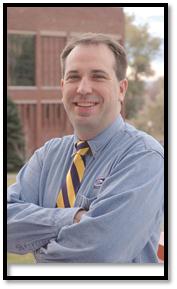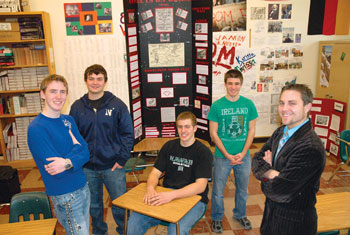University Communications and Marketing
Studying the past; benefiting the present
February 9, 2011
Contacts:
Dr. Tom Rust, History Department, 657-2891
Dan Carter, University Relations, 657-2269
Independent study shows Montana students who participate in National History Day through MSU Billings have proven boost in standardized test scores, school performance, job skills
MSU BILLINGS NEWS SERVICES — Bridger Smith, John Werner, Mikey Wall and Thomas Litton have become resident experts on the Treaty of Versailles at Billings Central Catholic High School.
And they’ve got a 7-foot tall display to prove it.
Thanks to a project done for National History Day coordinated by Montana State University Billings, the four seniors have been able to be do actual research into an important historical topic and find a way to show that knowledge that goes beyond the typical term paper.
And now there is evidence that students who participate in the National History Day (NHD) educational program, perform better on high-stakes tests, are better writers, more confident and capable researchers, and have a more mature perspective on current events and civic engagement than their peers, according to the first independent national evaluation of the widely used curricular program. Participants also show a greater ability to collaborate with peers, manage their time and persevere – all skills employers say are lacking in today’s workforce.
Montana National History Day is coordinated by the History Department at Montana State University Billings and overseen by Dr. Tom Rust, an assistant professor of history. MSU Billings, with support from the Montana Association of REALTORS and the Montana State Historical Society, has run the program in Montana for the past three years. The university coordinates the regional and state-level competitions and provides support for teachers and students throughout the school year.
 This year, more than 1,000 students from 11 schools and the home school community
are taking part in the program. The statewide competition is held in the spring of
each year, but teachers are urged to use the curriculum throughout the school year.
This year, more than 1,000 students from 11 schools and the home school community
are taking part in the program. The statewide competition is held in the spring of
each year, but teachers are urged to use the curriculum throughout the school year.
“We’ve known about the about the impact of this program for years,” said Rust. “This study is exciting since it provides scientific data to confirm it. It is especially exciting to see that a project-based program that focuses on history improves students’ scores on standardized test in other subjects like English and math.”
BRINGING HISTORY TO LIFE
National History Day is a yearlong academic program for elementary and secondary
school students focused on historical research, interpretation, and creative expression.
NHD students become writers, filmmakers, Web designers, playwrights, and artists as
they create unique contemporary expressions of history.
When Smith, Werner, Wall and Litton took on the Treaty of Versailles (the peace settlement after World War I) for advanced-level history teacher Shane Fairbanks at Central, they didn’t know what direction they would go and enjoyed the freedom to explore their options.
“We went over the treaty a little bit in class, but that was about it,” said Werner.
After reviewing some original and contemporary sources and doing a lot of reading, the four decided to construct a display that outlines the different articles in the treaty and focused on how the historical events, personalities and cultural events of the time that essentially pushed Germany toward World War II. The display contains profiles of the political personalities of the time and student perspectives on how the rest of the world treated a defeated Germany after World War I.
“Everyone knew Germany was outraged, but they didn’t know the extent,” said Litton. “It was interesting to learn about all of this from a loser’s perspective.”
Fairbanks, who is a graduate of the MSU Billings, said the expertise demonstrated by his high school students and shows how the National History Day program prepares them to succeed. It may be challenging, but it helps them embrace a topic and really learn it.
“The benefit is that this diversifies the classroom and the work beyond the normal research papers which they find boring,” he said. “This is something that they can really get into.”
He added that the National History Day curriculum forces students to push their comfort zones. About 50 of his students have taken part in the National History Day program, he said.
“Using History Day in my classroom has been one of the best curriculum decisions I have ever made,” Fairbanks said. “Students initially find it daunting. By the time we get to the competition, my students exude pride and enthusiasm about the wealth of knowledge that they have accumulated about their topic since the beginning of the year.”
The recent study shows that National History Day is a program that is applicable to all students from gifted and talented to those with documented learning disabilities.
“Across the state I’ve seen students who otherwise struggle excel doing National History Day – it is really heartwarming,” Rust said.
Like Fairbanks, teachers who use the program attest to its success.
Casey Visser, a middle school teacher at Lewis and Clark Junior High in Billings said the curriculum “helps prepare the students for so much more than history. I believe that it really does helps prepare the students for their standardized tests as well . . . It helps all students achieve, not only the high functioning ones, but the ones who struggle as well.”
Shannon Hellman, a middle school teacher in Glendive stated that “this project allowed for cross-curricular collaboration between teachers and students and were given the opportunity to demonstrate their language skills in history class. It has been an excellent opportunity for students to take ownership of their own learning process. At the school and state contest, my students were able show off their projects and all of my students were smiling from ear to ear. Not only were their teachers proud of them, but they were proud of themselves. It was amazing.”
A smaller study that focused just on Montana students found similar results.
“Students in our study demonstrated significant gains in college-readiness skills, such as their ability to conduct research, work with primary sources, write a thesis statement and create a bibliography, compared to their peers who did not participate in the program” said Dr. Michael Scarlett, an assistant professor of education at MSU Billings.
Kirby Lambert, the Outreach Manager at the Montana Historical Society in Helena agreed. “It’s exciting to see young people come to realize the significance of history to their own lives. Particularly when they research local topics, they come to see how their communities are connected to the larger national story. It’s one of the reasons the Montana Historical Society is so pleased to be a cosponsor of Montana History Day,” he said.
ABOUT THE STUDY
While many Montana educators say they see multifaceted student improvement in the
classroom, the recent report reinforces their impressions with scientific data. The
full report, “National History Day Works,” is available at www.nhd.org/NHDWorks. Some of the important findings include:
- NHD students outperform their non-NHD peers on state standardized tests, not only in social studies, but in reading, science and math as well. For example,
- In 2008-2009 in Texas, twice as many NHD students achieved “commended performance” as non-NHD students (87 percent vs. 37 percent) on the social studies assessment of the Texas Assessment of Knowledge and Skills (TAKS)
- At a South Carolina middle school where NHD was part of the curriculum for all eighth graders, students scored higher than students in a non-NHD middle school on the Language Arts, Math and Science segments of the 2008-09 PASS test.
- NHD students are better writers, who write with a purpose and real voice, and marshal solid evidence to support their point of view. NHD students outscored comparison-group students on both pre- and post-writing assessments, receiving more high scores (5s or 6s) on a 6-point scale, and fewer low scores. NHD essays had more sentence variety, richer vocabulary, a more authentic voice, and better organization.
- NHD students are critical thinkers who can digest, analyze and synthesize information. Performance assessments show that NHD students overall were significantly better than their peers at interpreting historical information, with an average of 79 percent vs. 61 percent correct.
- NHD students learn 21st Century skills. They learn how to collaborate with team members, talk to experts, manage their time and persevere.
- NHD has a positive impact among students whose interests in academic subjects may wane in high school. Analyses show that among Black and Hispanic students, NHD students outperform non-NHD students, posting higher performance assessment scores and levels of interests and skills. Compared to non-NHD boys, and to all girls, boys participating in NHD reported significantly higher levels of interest in history, civic engagement, and confidence in research skills, on both pre- and post-surveys.
Conducted by San Francisco-based research firm Rockman, et al, the study looked at performance assessments, surveys and standardized test scores to evaluate students’ research and writing skills, ability to interpret historical information, academic performance and interest in past and current events. Researchers then compared their evaluations of students who participated in National History Day (NHD) to their peers who did not participate in the program.
The study, conducted at four sites around the country, found that on nearly every measure, NHD students’ scores or ratings were higher than their peers who did not participate in the program. The sites evaluated included school districts in urban, suburban and rural settings: Aldine Unified School District, Houston, Texas; Chesterfield County Schools, Chesterfield, S.C.; a large public school district in Colorado; and Paterson Public Schools, Paterson, N.J.
The survey included a slightly higher sample of African American and Hispanic students compared to the population breakdown in U.S. public schools.
 ABOUT NATIONAL HISTORY DAY
ABOUT NATIONAL HISTORY DAY
Montana is a relative newcomer to the National History Day Program, starting in 2008
and having the first state competition in 2009. It has grown dramatically in its three-year
history, from 48 participants in two schools during the 2008-09 school year to over
a 1,000 participating in 12 schools from Glendive to Corvallis.
“The growth has been incredibly fast and I think it speaks to the obvious value of the program” said Rust.
In 2010, the Montana Association of REALTORS donated $15,000 to help further develop the program.
“The Montana Association of Realtors promotes quality of life issues as its major focus. When the opportunity to sponsor Montana History Day came about, the association saw a way to help the children of our state enjoy a program that encourages the active study of history through involvement” said realtor Frosty Erben. “It is a way for us to give back something of value and support a unique opportunity for our children.”
The annual contest is held on the MSU Billings main campus in April of each year and is open to the public. The program culminates in a national competition each June held at the University of Maryland at College Park.
“I encourage the public to come see what these students can do. The projects are wonderful and frankly, it just fun to see them” said Rust.
To find out more about the program, go to www.nhd.org. or http://mtnhd.weebly.com or contact Rust at 657-2891.
PHOTO ABOVE: These four Advance Placement history students at Billings Central Catholic High School are among the dozens at the school who will participate in the Montana National History Day program coordinated by Montana State University Billings. From left to right they are Thomas Litton, Bridger Smith, John Werner and Mikey Wall. Behind them is a display board the four did about the Treaty of Versailles that will be used for this year’s competition. At far right is their teacher, Shane Fairbanks. Fairbanks is also a graduate of MSU Billings.
